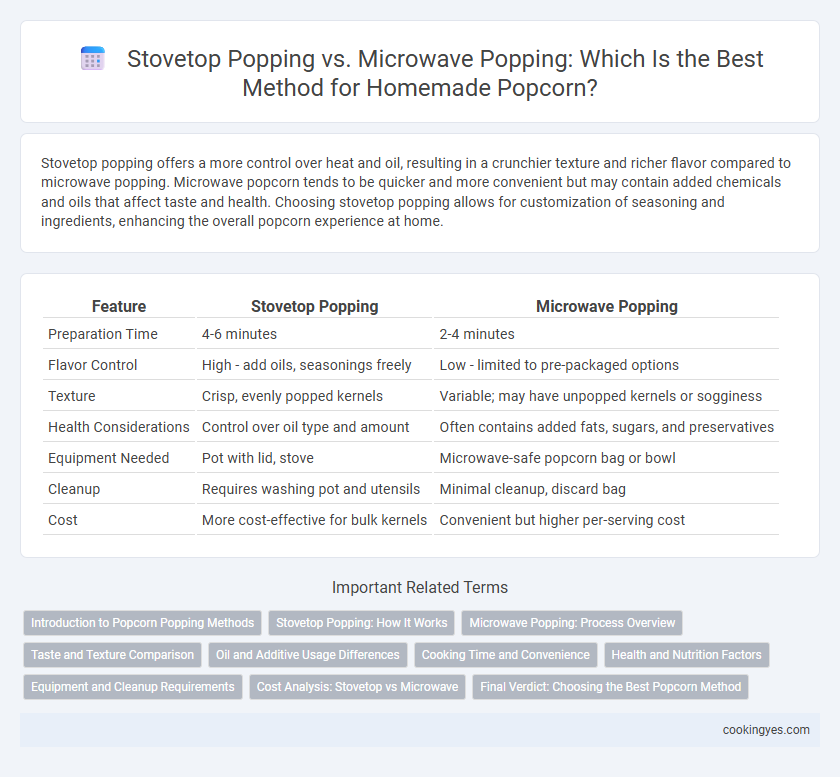Stovetop popping offers a more control over heat and oil, resulting in a crunchier texture and richer flavor compared to microwave popping. Microwave popcorn tends to be quicker and more convenient but may contain added chemicals and oils that affect taste and health. Choosing stovetop popping allows for customization of seasoning and ingredients, enhancing the overall popcorn experience at home.
Table of Comparison
| Feature | Stovetop Popping | Microwave Popping |
|---|---|---|
| Preparation Time | 4-6 minutes | 2-4 minutes |
| Flavor Control | High - add oils, seasonings freely | Low - limited to pre-packaged options |
| Texture | Crisp, evenly popped kernels | Variable; may have unpopped kernels or sogginess |
| Health Considerations | Control over oil type and amount | Often contains added fats, sugars, and preservatives |
| Equipment Needed | Pot with lid, stove | Microwave-safe popcorn bag or bowl |
| Cleanup | Requires washing pot and utensils | Minimal cleanup, discard bag |
| Cost | More cost-effective for bulk kernels | Convenient but higher per-serving cost |
Introduction to Popcorn Popping Methods
Stovetop popping utilizes direct heat and oil to evenly heat popcorn kernels, resulting in crispy, flavorful popcorn with control over seasoning and texture. Microwave popping offers convenience and speed by using pre-packaged bags with built-in heating elements, though it may sacrifice some flavor and yield consistency. Choosing between stovetop and microwave methods depends on preferences for taste, preparation time, and control over ingredients.
Stovetop Popping: How It Works
Stovetop popping involves heating oil in a pot until it reaches around 400degF, ensuring even heat distribution for popcorn kernels to pop effectively. The kernels absorb the hot oil, causing moisture inside them to turn into steam, which creates pressure until the hull bursts open. This method allows control over the oil type and quantity, resulting in a crispier texture and richer flavor compared to microwave popping.
Microwave Popping: Process Overview
Microwave popping of popcorn involves heating specially designed bags containing pre-measured kernels and oil, which generate steam to burst the kernels rapidly. The enclosed environment ensures even heat distribution and precise temperature control, resulting in consistent popping efficiency and minimal burning. This method offers convenience and speed while preserving optimal texture and flavor for home preparation.
Taste and Texture Comparison
Stovetop popping produces popcorn with a richer, more robust flavor and a crunchier, more evenly cooked texture due to the direct heat and control over oil temperature. Microwave popping often results in a lighter, sometimes slightly soggy texture and a less intense, sometimes artificial taste because of pre-packaged oils and flavorings. Home cooks seeking maximum flavor and crispness typically prefer stovetop methods for better texture and taste consistency.
Oil and Additive Usage Differences
Stovetop popping requires oil to evenly heat kernels, enhancing flavor and texture, while microwave popping mainly uses pre-packaged bags with added oils and artificial additives for convenience. The stovetop method allows control over the type and amount of oil, often resulting in a fresher, less processed snack compared to microwave popcorn that typically contains preservatives and flavor enhancers. Choosing stovetop popping reduces exposure to additives like diacetyl and excessive sodium commonly found in microwave popcorn brands.
Cooking Time and Convenience
Stovetop popping typically takes 5-7 minutes, offering precise heat control for customizable crispness, while microwave popping completes in 2-4 minutes, providing quick and effortless preparation with minimal cleanup. Stovetop methods require active attention to prevent burning, whereas microwaves offer one-touch convenience ideal for fast snacking. Choosing between them depends on balancing desired texture and hands-on cooking involvement versus speed and ease.
Health and Nutrition Factors
Stovetop popping uses natural oil and whole kernels, allowing control over oil type and quantities, which can reduce unhealthy trans fats and additives common in microwave popcorn. Microwave popcorn often contains added preservatives, artificial flavors, and high sodium levels, potentially impacting heart health and increasing calorie intake. Choosing stovetop popcorn helps avoid chemical residues and offers a cleaner, nutrient-rich snack with higher antioxidant retention from freshly popped kernels.
Equipment and Cleanup Requirements
Stovetop popping requires a pot with a lid and a heat source, offering precise temperature control but involves washing cookware and potential oil residue cleanup. Microwave popping uses specialized bags or microwave-safe containers designed for convenience and minimal cleanup, often limited to discarding the bag. Equipment for stovetop popping is reusable and typically more durable, while microwave popping equipment emphasizes ease of use and quick disposal.
Cost Analysis: Stovetop vs Microwave
Stovetop popping requires minimal investment with just a pot and oil, typically costing only a few cents per serving, whereas microwave popcorn involves purchasing pre-packaged bags that average $0.30 to $0.50 each. The upfront expense of stovetop equipment is lower, and in the long run, the cost per serving is substantially reduced compared to microwave options. Energy consumption for stovetop popping can be higher, but the overall cost-efficiency favors stovetop methods due to the lower price of bulk kernels versus microwave packets.
Final Verdict: Choosing the Best Popcorn Method
Stovetop popping yields a richer, fresher flavor with customizable oil and seasoning options, making it ideal for popcorn enthusiasts seeking control over texture and taste. Microwave popping offers unmatched convenience and speed, perfect for quick snacks without cleanup, though it may sacrifice some flavor depth. Choosing the best popcorn method depends on whether you prioritize taste customization and quality or ease and speed in home preparation.
Stovetop Popping vs Microwave Popping for home preparation Infographic

 cookingyes.com
cookingyes.com